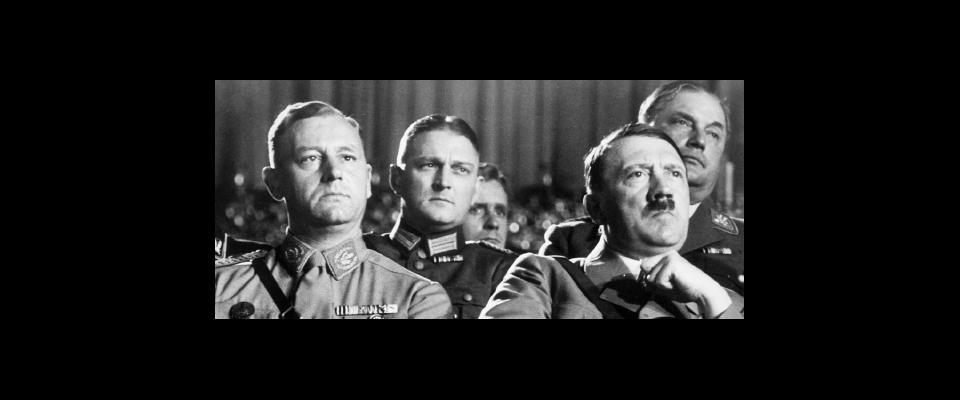Excerpt from The Collaboration: Hollywood’s Pact with Hitler by Ben Urwand, Ph.D. ‘11 (Harvard University Press, September 2013)
The collaboration of American movie studios with Nazi Germany was complex and multifaceted, and as the decade progressed, it evolved in a clearly discernible way. More and more, the Nazis dictated the terms of every encounter, and the studios, instead of leaving the German market, did everything they could to remain. As the years passed, fewer American movies were shown in Germany, but as long as the studios pandered to the whims of the Nazi regime, the collaboration remained as strong as ever.
Only at one point late in the decade did anyone mount a serious challenge to the prevailing state of affairs. A powerful organization questioned the very morality of the relationship between Hollywood and Germany and even suggested that the relationship should not be permitted to continue. The organization was not one of the American studios, however, nor was it a pressure group based in the United States. It was the SS.
In the first half of the 1930s, film critics in Germany had been more than eager to say what they thought about Hollywood movies. The vast majority treated the movies with a sense of awe and astonishment. They praised the Americans’ technical superiority, they delighted in the “light comedy touch,” and they complimented the deep understanding of the leader principle. A significant number of German film critics, however, felt that the movies they were watching were too American. They therefore dismissed Hollywood productions as kitsch, they attacked the excessive sentimentality of the story lines, and they made fun of the happy endings. Taken as a whole, German film criticism of Hollywood in this early period consisted of a curious mixture of unbridled enthusiasm and predictable anti-Americanism.
Then, in late 1936, Joseph Goebbels abolished film criticism in Germany and ordered journalists to provide “film description” instead. His employees in the Propaganda Ministry began issuing instructions on how to write about specific American movies. The vast majority of reviewers adhered to these directives, and as a result, German film writing in the latter half of the 1930s became increasingly bland. The reviews simply gave brief plot summaries along with a few trivial observations about the films in question. True criticism all but disappeared.
Every now and then, though, an article appeared in the German press that was not only thoughtful but also questioned the whole validity of showing American movies in Germany. In April 1938, a critic named Wilhelm Frels published one such article about the latest technological innovation in Hollywood: the arrival of Technicolor. Frels examined two of the earliest Technicolor movies, Ramona and Wings of the Morning, both of which had recently been shown in Germany, but unlike everyone else he was not interested in how these films had been improved by the new technology. He was more concerned with how these films had fooled the unsuspecting German public. As he explained: “Colored films love to use colored people because of their more effective skin tone.”
He was absolutely right. Both Ramona and Wings of the Morning had told stories about nonwhites, and both films had lingered on their characters’ bodies as objects of attraction and fascination. It is unlikely that any other reviewer had picked up on this connection before.
It was certainly very strange that Wings of the Morning—a movie that glorified gypsies—had been permitted in Germany at this particular point in time. Only nine months earlier, the chief censor Dr. Seeger had banned a Laurel and Hardy picture called The Bohemian Girl because it portrayed gypsies in a sympathetic light. How, then, could the censors have permitted Wings of the Morning, a much more serious picture that explicitly spoke out on behalf of this persecuted people?
Here is the likely answer: Ever since the censors had started checking up on the racial origins of a film’s cast and crew, they had been paying less attention to the film itself. They had spent so much of their time researching the background of Hollywood personalities that they had sometimes forgotten to take into account a film’s actual content. Consequently, a few titles had slipped through.
At the beginning of 1940, a Shirley Temple movie entitled Susannah of the Mounties was screened in Germany. The German public adored Shirley Temple—Goebbels called her “a wonderful child”—but this film, like Ramona, was about the relationship between whites and Indians in the United States. Given the sensitivity of this subject matter, the Propaganda Ministry carefully told the press how to review it: “In Susannah of the Mounties (Fox), the little Shirley Temple reveals her incredible gift with great poignancy. The Wild West plot she has been placed in provides a good setting for this entertainment, too.”
The newspapers all followed these instructions and reviewed Susannah of the Mounties as an example of harmless entertainment. But the SS—Hitler’s major paramilitary organization—appeared to have picked up on something truly disturbing (from their perspective) about the picture. Just a few minutes before the end, Shirley Temple pricked her finger and exchanged her blood with the blood of a young Indian boy. The SS soon expressed anger “that films with Shirley Temple are currently being screened in Munich,” and added: “We are lodging particular complaints against the press articles that cast Susannah of the Mounties in a most positive light.”
A few months later, the SS reacted to a different film that was still being screened at theaters throughout Germany: Ramona. “The main criticism of the plot was that an Indian, whom the whites had originally hated, was suddenly considered their equal at the moment he converted to Catholicism,” the SS said. “It was felt to be incomprehensible that a film whose content so grossly contradicts National Socialist ideology could still be shown.”
The SS had picked up on a glaring contradiction, but even this powerful organization could not bring an end to the relationship with the Hollywood studios. The relationship continued, and more American movies that contradicted National Socialist ideology were shown in Germany, for two simple reasons: the censors were approving films with little or no regard to content, and the Propaganda Ministry was issuing instructions on how these films needed to be reviewed in the newspapers.





















